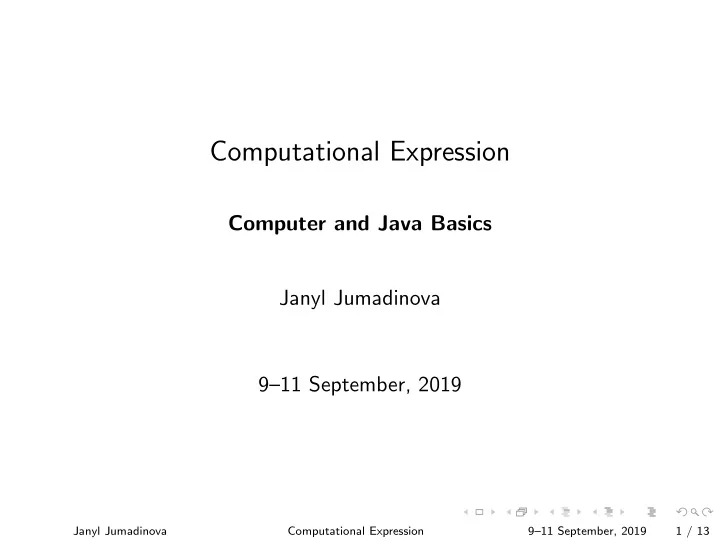

Computational Expression Computer and Java Basics Janyl Jumadinova 9–11 September, 2019 Janyl Jumadinova Computational Expression 9–11 September, 2019 1 / 13
Character Strings string literal in class String “ABC” “This is interesting” “ ” “91” Janyl Jumadinova Computational Expression 9–11 September, 2019 2 / 13
Character Strings string literal in class String “ABC” “This is interesting” “ ” “91” Use print or println methods to print a character string to the terminal System.out.println(“CMPSC 100”); the string “CMPSC 100” is a parameter: data sent to a method Janyl Jumadinova Computational Expression 9–11 September, 2019 2 / 13
String Concatenation Appending one string to the end of another: use + operator “This is ”+ “interesting” “Your grade is ”+ “91” Janyl Jumadinova Computational Expression 9–11 September, 2019 3 / 13
String Concatenation Appending one string to the end of another: use + operator “This is ”+ “interesting” “Your grade is ”+ “91” + is also used for arithmetic addition System.out.println(”Adding ”+ 12 + 23); is not the same as System.out.println(”Adding ”+ (12 + 23)); Janyl Jumadinova Computational Expression 9–11 September, 2019 3 / 13
Escape Sequences Escape sequences, or escape characters, begin with a slash and are immediately followed by another character. This two-character sequence, inside “ ” allows you to control your output ( \ n, \ t, \ b) or output characters you wouldn’t otherwise be able to ( \\ , \ ”) inside a string. Janyl Jumadinova Computational Expression 9–11 September, 2019 4 / 13
Escape Sequences Seq Meaning Example Code \ n New line System.out.println(”Hi \ nThere”); \ t Horizontal tab System.out.println(”What’s \ tup?”); \ b Backspace System.out.println(”Hi \ b Hey”); \\ Backslash System.out.println(”Back \\ Slash”); \ ” Double quote System.out.println(”Dbl \ ”Quote”); Janyl Jumadinova Computational Expression 9–11 September, 2019 5 / 13
Variables Variable is a name for a memory’s location where a data value is stored. Janyl Jumadinova Computational Expression 9–11 September, 2019 6 / 13
Variables Variable is a name for a memory’s location where a data value is stored. Variable Declaration allows the compiler to reserve space in the main memory that is large enough for the specified type int count; Janyl Jumadinova Computational Expression 9–11 September, 2019 6 / 13
Variables Variable is a name for a memory’s location where a data value is stored. Variable Declaration allows the compiler to reserve space in the main memory that is large enough for the specified type int count; Variable Assignment assigns a value to the variable count = 0; Janyl Jumadinova Computational Expression 9–11 September, 2019 6 / 13
Variables Variable is a name for a memory’s location where a data value is stored. Variable Declaration allows the compiler to reserve space in the main memory that is large enough for the specified type int count; Variable Assignment assigns a value to the variable count = 0; Must give a value to the variable before using it in the main method. Janyl Jumadinova Computational Expression 9–11 September, 2019 6 / 13
Java Identifiers reserved keywords (class, public, static, void) Java classes, methods, variables: words we chose or make up when writing a program System, println, main, args Janyl Jumadinova Computational Expression 9–11 September, 2019 7 / 13
Java Identifiers reserved keywords (class, public, static, void) Java classes, methods, variables: words we chose or make up when writing a program System, println, main, args Identifier a letter followed by zero or more letters (including $ and ) and digits Janyl Jumadinova Computational Expression 9–11 September, 2019 7 / 13
Identifier Rules Identifiers must start with a letter, a currency character ($), or a connecting character such as the underscore ( ). Identifiers cannot start with a number. After the first character, identifiers can contain any combination of letters, currency characters, connecting characters, or numbers. There is no limit to the number of characters an identifier can contain. You can’t use a Java keyword as an identifier. Identifiers in Java are case-sensitive; foo and FOO are two different identifiers. Janyl Jumadinova Computational Expression 9–11 September, 2019 8 / 13
Data Types Data stored in memory is a string of bits (0 or 1) Janyl Jumadinova Computational Expression 9–11 September, 2019 9 / 13
Data Types Data stored in memory is a string of bits (0 or 1) How the computer interprets the string of bits depends on the context. In Java, we must make the context explicit by specifying the type of the data. Janyl Jumadinova Computational Expression 9–11 September, 2019 9 / 13
Data Types Java has two categories of data: primitive data (e.g., number, character) object data (programmer created types) There are 8 primitive data types: byte, short, int, long, float, double, char, boolean Primitive data are only single values; they have no special capabilities. Janyl Jumadinova Computational Expression 9–11 September, 2019 10 / 13
Primitive Data Types integers: byte, short, int, long floating point: float, double characters: char booleans: boolean Janyl Jumadinova Computational Expression 9–11 September, 2019 11 / 13
Common Primitive Data Types Type Description Example of Literals integers (whole numbers) 42, 60634, -8 int real numbers 0.039, -10.2 double single characters ’a’, ’B’, ’&’, ’6’ char logical values true, false boolean Janyl Jumadinova Computational Expression 9–11 September, 2019 12 / 13
Range of Values Type Storage Range of Values 32 bits -2,147,483,648 to 2,147,483,647 int ± 10 − 45 to ± 10 38 64 bits double 0 to 2 16 or \ u0000 to \ uFFFF 16 bits = 2 bytes char 1 bit NA boolean Janyl Jumadinova Computational Expression 9–11 September, 2019 13 / 13
Recommend
More recommend